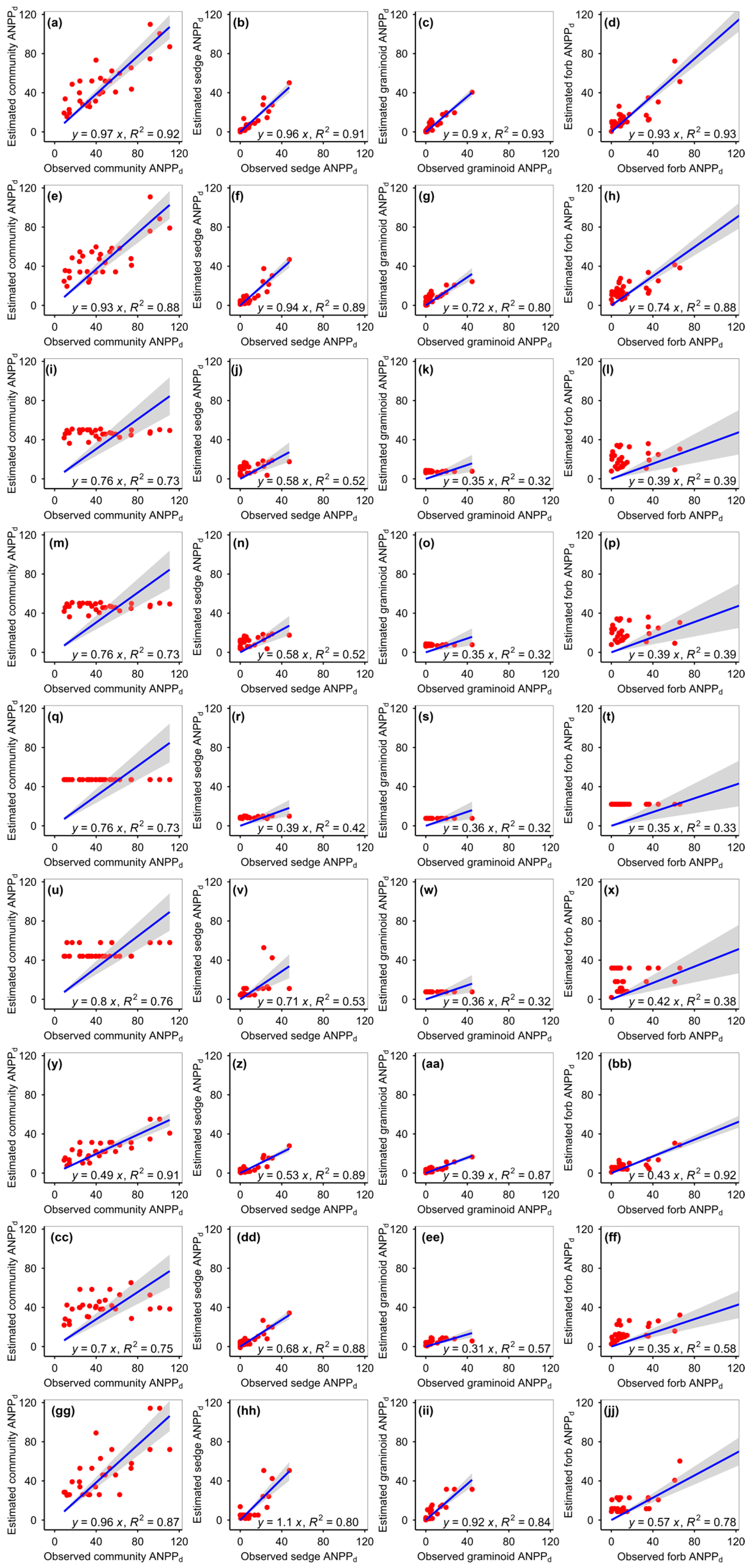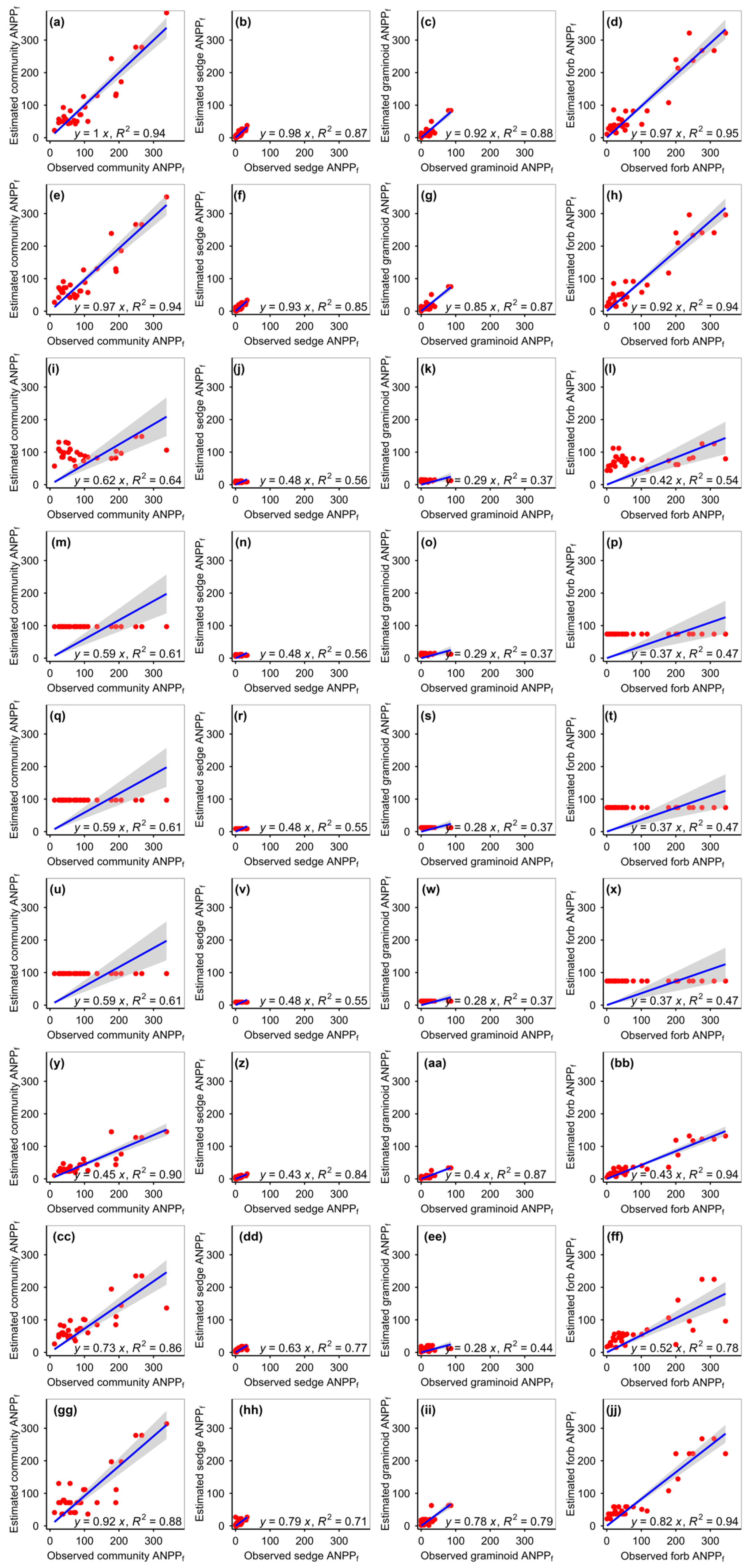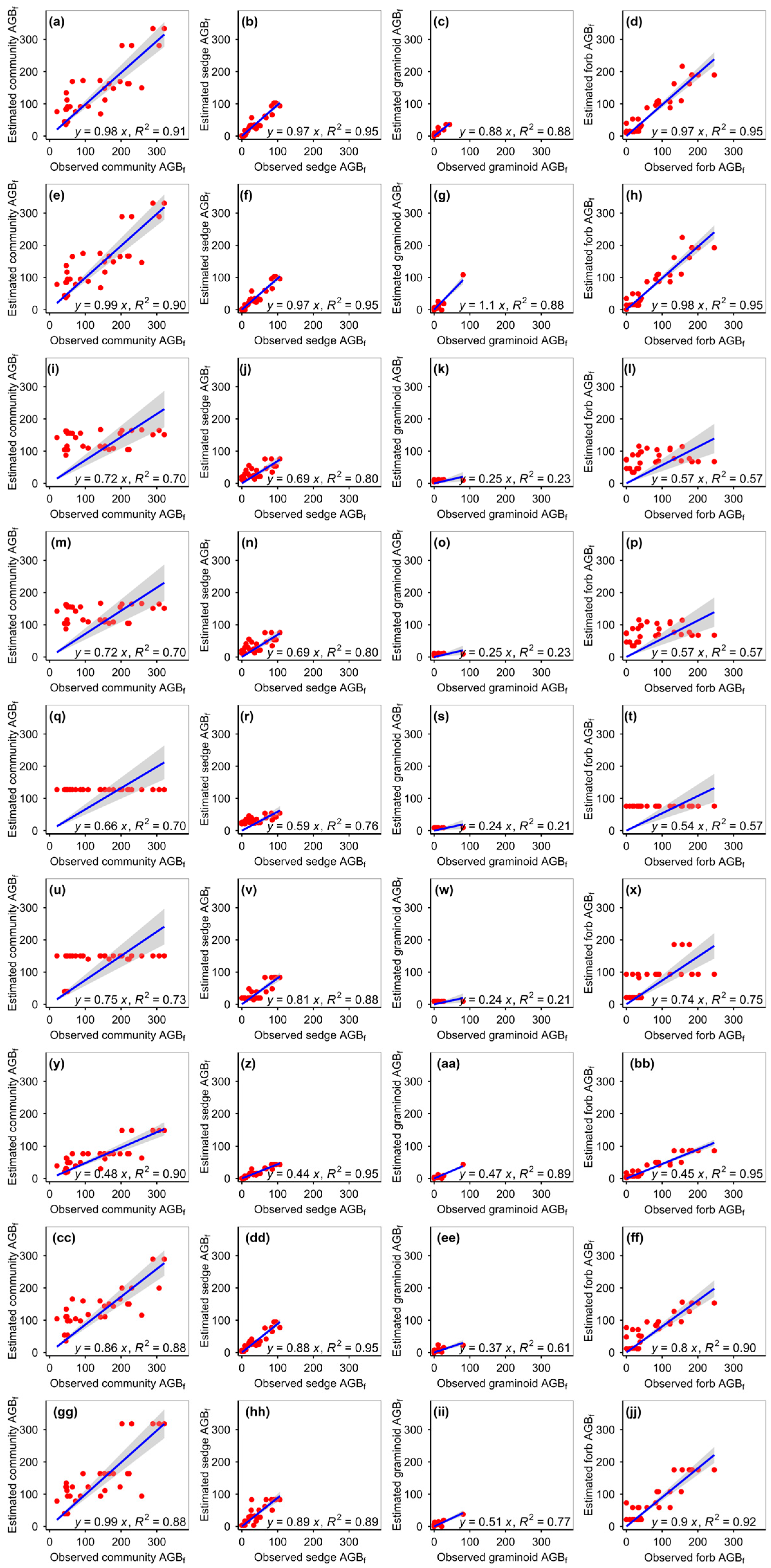Modelling Fresh and Dry Weight of Aboveground Biomass of Plant Community and Taxonomic Group Using Normalized Difference Vegetation Index and Climate Data in Xizang’s Grasslands
Abstract
1. Introduction
2. Materials and Methods
2.1. Study Area and Plant Sampling
2.2. Normalized Difference Vegetation Index and Climate Data
2.3. Model Methodology
2.3.1. RFM
2.3.2. GBRM
2.3.3. SVMM
2.3.4. MLRM
2.3.5. RRTM
2.3.6. ANNM
2.3.7. GLRM
2.3.8. CITM
2.3.9. eXGBM
2.4. Model Accuracy Evaluation
3. Results
3.1. Model Construction
3.2. Model Validation
4. Discussion
5. Conclusions
Supplementary Materials
Author Contributions
Funding
Data Availability Statement
Acknowledgments
Conflicts of Interest
References
- O’Mara, F.P. The role of grasslands in food security and climate change. Ann. Bot. 2012, 110, 1263–1270. [Google Scholar] [CrossRef] [PubMed]
- Guo, X.W.; Zhou, H.K.; Dai, L.C.; Li, J.; Zhang, F.W.; Li, Y.K.; Lin, L.; Li, Q.; Qian, D.W.; Fan, B.; et al. Restoration of Degraded Grassland Significantly Improves Water Storage in Alpine Grasslands in the Qinghai-Tibet Plateau. Front. Plant Sci. 2021, 12, 778656. [Google Scholar] [CrossRef]
- Liu, Y.; Zhao, L.R.; Liu, Y.F.; Huang, Z.; Shi, J.J.; Wang, Y.L.; Ma, Y.S.; Lucas-Borja, M.E.; López-Vicente, M.; Wu, G.L. Restoration of a hillslope grassland with an ecological grass species (Elymus tangutorum) favors rainfall interception and water infiltration and reduces soil loss on the Qinghai-Tibetan Plateau. Catena 2022, 219, 106632. [Google Scholar] [CrossRef]
- Lee, M.; Manning, P.; Rist, J.; Power, S.A.; Marsh, C. A global comparison of grassland biomass responses to CO2 and nitrogen enrichment. Philos. Trans. R. Soc. B-Biol. Sci. 2010, 365, 2047–2056. [Google Scholar] [CrossRef]
- Dong, S.K.; Shang, Z.H.; Gao, J.X.; Boone, R.B. Enhancing sustainability of grassland ecosystems through ecological restoration and grazing management in an era of climate change on Qinghai-Tibetan Plateau. Agr. Ecosyst. Environ. 2020, 287, 106684. [Google Scholar] [CrossRef]
- Borsellino, V.; Schimmenti, E.; El Bilali, H. Agri-Food Markets towards Sustainable Patterns. Sustainability 2020, 12, 2193. [Google Scholar] [CrossRef]
- Salter, A.M.; Lopez-Viso, C. Role of novel protein sources in sustainably meeting future global requirements. Proc. Nutr. Soc. 2021, 80, 186–194. [Google Scholar] [CrossRef]
- Flachowsky, G.; Meyer, U.; Südekum, K.H. Land Use for Edible Protein of Animal Origin-A Review. Animals 2017, 7, 25. [Google Scholar] [CrossRef]
- Zeng, N.; Ren, X.L.; He, H.L.; Zhang, L.; Zhao, D.; Ge, R.; Li, P.; Niu, Z.E. Estimating grassland aboveground biomass on the Tibetan Plateau using a random forest algorithm. Ecol. Indic. 2019, 102, 479–487. [Google Scholar] [CrossRef]
- Morais, T.G.; Teixeira, R.F.M.; Figueiredo, M.; Domingos, T. The use of machine learning methods to estimate aboveground biomass of grasslands: A review. Ecol. Indic. 2021, 130, 108081. [Google Scholar] [CrossRef]
- Yao, X.; Chai, Q.; Chen, T.X.; Chen, Z.J.; Wei, X.K.; Bao, G.S.; Song, M.L.; Wei, W.R.; Zhang, X.X.; Li, C.J.; et al. Disturbance by grazing and the presence of rodents facilitates the dominance of the unpalatable grass Achnatherum inebrians in alpine meadows of northern China. Rangel. J. 2019, 41, 301–312. [Google Scholar] [CrossRef]
- Zhao, M.L.; Gao, X.L.; Wang, J.; He, X.L.; Han, B. A review of the most economically important poisonous plants to the livestock industry on temperate grasslands of China. J. Appl. Toxicol. 2013, 33, 9–17. [Google Scholar] [CrossRef] [PubMed]
- Han, F.; Yu, C.; Fu, G. Non-growing/growing season non-uniform-warming increases precipitation use efficiency but reduces its temporal stability in an alpine meadow. Front. Plant Sci. 2023, 14, 1090204. [Google Scholar] [CrossRef] [PubMed]
- Chen, X.; Luo, M.Y.; Larjavaara, M. Effects of climate and plant functional types on forest above-ground biomass accumulation. Carbon Balance Manag. 2023, 18, 5. [Google Scholar] [CrossRef] [PubMed]
- Zeng, N.; Ren, X.L.; He, H.L.; Zhang, L.; Li, P.; Niu, O.G. Estimating the grassland aboveground biomass in the Three-River Headwater Region of China using machine learning and Bayesian model averaging. Environ. Res. Lett. 2021, 16, 114020. [Google Scholar] [CrossRef]
- Wang, G.Q.; Liu, S.M.; Liu, T.X.; Fu, Z.Y.; Yu, J.S.; Xue, B.L. Modelling above-ground biomass based on vegetation indexes: A modified approach for biomass estimation in semi-arid grasslands. Int. J. Remote Sens. 2019, 40, 3835–3854. [Google Scholar] [CrossRef]
- Ma, X.L.; Ma, Y.J. The spatiotemporal variation analysis of virtual water for agriculture and livestock husbandry: A study for Jilin Province in China. Sci. Total Environ. 2017, 586, 1150–1161. [Google Scholar] [CrossRef] [PubMed]
- Leng, G.Y.; Hall, J.W. Where is the Planetary Boundary for freshwater being exceeded because of livestock farming? Sci. Total Environ. 2021, 760, 144035. [Google Scholar] [CrossRef] [PubMed]
- Wei, Y.Q.; Wang, S.J.; Fang, Y.P.; Nawaz, Z. Integrated assessment on the vulnerability of animal husbandry to snow disasters under climate change in the Qinghai-Tibetan Plateau. Glob. Planet. Change 2017, 157, 139–152. [Google Scholar] [CrossRef]
- Wen, L.; Dong, S.K.; Li, Y.Y.; Pulver, C.; Li, X.Y.; Shi, J.J.; Wang, Y.L.; Ma, Y.S.; Liu, D.M. Variation of botanical composition, forage production and nutrient values along a grassland degradation gradient in the alpine region of Qinghai-Tibet Plateau. Phyton-Int. J. Exp. Bot. 2013, 82, 45–54. [Google Scholar]
- Gao, X.X.; Dong, S.K.; Li, S.; Xu, Y.D.; Liu, S.L.; Zhao, H.D.; Yeomans, J.; Li, Y.; Shen, H.; Wu, S.N.; et al. Using the random forest model and validated MODIS with the field spectrometer measurement promote the accuracy of estimating aboveground biomass and coverage of alpine grasslands on the Qinghai-Tibetan Plateau. Ecol. Indic. 2020, 112, 106114. [Google Scholar] [CrossRef]
- Jia, Z.Y.; Zhang, Z.H.; Cheng, Y.X.; Buhebaoyin; Borjigin, S.; Quan, Z.J. Grassland biomass spatiotemporal patterns and response to climate change in eastern Inner Mongolia based on XGBoost model estimates. Ecol. Indic. 2024, 158, 111554. [Google Scholar] [CrossRef]
- Pham, T.D.; Le, N.N.; Ha, N.T.; Nguyen, L.V.; Xia, J.S.; Yokoya, N.; To, T.T.; Trinh, H.X.; Kieu, L.Q.; Takeuchi, W. Estimating Mangrove Above-Ground Biomass Using Extreme Gradient Boosting Decision Trees Algorithm with Fused Sentinel-2 and ALOS-2 PALSAR-2 Data in Can Gio Biosphere Reserve, Vietnam. Remote Sens. 2020, 12, 777. [Google Scholar] [CrossRef]
- Tian, Y.; Fu, G. Quantifying Plant Species α-Diversity Using Normalized Difference Vegetation Index and Climate Data in Alpine Grasslands. Remote Sens. 2022, 14, 5007. [Google Scholar] [CrossRef]
- Wang, S.H.; Fu, G. Modelling soil moisture using climate data and normalized difference vegetation index based on nine algorithms in alpine grasslands. Front. Environ. Sci. 2023, 11, 1130448. [Google Scholar] [CrossRef]
- Huang, S.; Fu, G. Impacts of climate change and human activities on plant species α-diversity across the Tibetan grasslands. Remote Sens. 2023, 15, 2947. [Google Scholar] [CrossRef]
- Ran, Q.W.; Hao, Y.B.; Xia, A.Q.; Liu, W.J.; Hu, R.H.; Cui, X.Y.; Xue, K.; Song, X.N.; Xu, C.; Ding, B.Y.; et al. Quantitative Assessment of the Impact of Physical and Anthropogenic Factors on Vegetation Spatial-Temporal Variation in Northern Tibet. Remote Sens. 2019, 11, 1183. [Google Scholar] [CrossRef]
- Chen, Y.; Xu, E. The Spatiotemporal Change in Land Cover and Discrepancies within Different Countries on the Qinghai-Tibet Plateau over a Recent 30-Year Period. Land 2023, 12, 1797. [Google Scholar] [CrossRef]
- Ding, J.Z.; Yang, T.; Zhao, Y.T.; Liu, D.; Wang, X.Y.; Yao, Y.T.; Peng, S.S.; Wang, T.; Piao, S.L. Increasingly Important Role of Atmospheric Aridity on Tibetan Alpine Grasslands. Geophys. Res. Lett. 2018, 45, 2852–2859. [Google Scholar] [CrossRef]
- Yang, J.; Dong, J.; Xiao, X.; Dai, J.; Wu, C.; Xia, J.; Zhao, G.; Zhao, M.; Li, Z.; Zhang, Y.; et al. Divergent shifts in peak photosynthesis timing of temperate and alpine grasslands in China. Remote Sens. Environ. 2019, 233, 111395. [Google Scholar] [CrossRef]
- Fu, G.; Sun, W.; Li, S.W.; Zhang, J.; Yu, C.Q.; Shen, Z.X. Modeling aboveground biomass using MODIS images and climatic data in grasslands on the Tibetan Plateau. J. Resour. Ecol. 2017, 8, 42–49. [Google Scholar]
- Zhang, G.; Fu, G. Changes in soil organic carbon, total nitrogen and total phosphorus in 2000–2020 and their driving mechanisms in Tibetan alpine grasslands. Glob. Planet. Chang. 2024, 239, 104484. [Google Scholar] [CrossRef]
- Han, F.; Fu, G.; Yu, C.; Wang, S. Modeling nutrition quality and storage of forage using climate data and normalized-difference vegetation index in alpine grasslands. Remote Sens. 2022, 14, 3410. [Google Scholar] [CrossRef]
- Sun, W.; Qi, H.; Li, T.; Qin, Y.; Fu, G.; Han, F.; Wang, S.; Pan, X. Modelling soil ammonium nitrogen, nitrate nitrogen and available phosphorus using normalized difference vegetation index and climate data in Xizang’s grasslands. Sustainability 2024, 16, 4695. [Google Scholar] [CrossRef]
- Rodriguez-Galiano, V.; Sanchez-Castillo, M.; Chica-Olmo, M.; Chica-Rivas, M. Machine learning predictive models for mineral prospectivity: An evaluation of neural networks, random forest, regression trees and support vector machines. Ore Geol. Rev. 2015, 71, 804–818. [Google Scholar] [CrossRef]
- Wang, L.A.; Zhou, X.D.; Zhu, X.K.; Dong, Z.D.; Guo, W.S. Estimation of biomass in wheat using random forest regression algorithm and remote sensing data. Crop J. 2016, 4, 212–219. [Google Scholar] [CrossRef]
- Wang, H.; Liu, H.Y.; Huang, N.; Bi, J.; Ma, X.L.; Ma, Z.Y.; Shangguan, Z.J.; Zhao, H.F.; Feng, Q.S.; Liang, T.G.; et al. Satellite-derived NDVI underestimates the advancement of alpine vegetation growth over the past three decades. Ecology 2021, 102, e03518. [Google Scholar] [CrossRef]
- Peñuelas, J.; Filella, I. Visible and near-infrared reflectance techniques for diagnosing plant physiological status. Trends Plant Sci. 1998, 3, 151–156. [Google Scholar] [CrossRef]
- Colwell, J.E. Vegetation canopy reflectance. Remote Sens. Environ. 1974, 3, 175–183. [Google Scholar] [CrossRef]
- Dubey, P.; Raghubanshi, A.S.; Singh, J.S. Intra-seasonal variation and relationship among leaf traits of different forest herbs in a dry tropical environment. Curr. Sci. 2011, 100, 69–76. [Google Scholar]
- Yang, Y.; Klanderud, K.; Yang, Y.H.; Jin, H.A.; Lu, Y.Q.; Zhang, T.Z.; Wang, G.X. Homogenization in Species Composition and No Change in Aboveground Biomass Across Tibetan Permafrost Regions Over Ten Years. Front. Environ. Sci. 2022, 10, 932993. [Google Scholar] [CrossRef]
- Wang, L.T.; Wang, S.X.; Zhou, Y.; Liu, W.L.; Wang, F.T. Vegetation Water Content Retrieval and Application of Drought Monitoring Using Multi-Spectral Remote Sensing. Spectrosc. Spectr. Anal. 2011, 31, 2804–2808. [Google Scholar] [CrossRef]
- Yu, Q.Y.; Ji, W.J.; Prihodko, L.; Ross, C.W.; Anchang, J.Y.; Hanan, N.P. Study becomes insight: Ecological learning from machine learning. Methods Ecol. Evol. 2021, 12, 2117–2128. [Google Scholar] [CrossRef]
- Cappart, Q.; Bergman, D.; Rousseau, L.M.; Prémont-Schwarz, I.; Parjadis, A. Improving Variable Orderings of Approximate Decision Diagrams Using Reinforcement Learning. Inf. J. Comput. 2022, 34, 2552–2570. [Google Scholar] [CrossRef]
- Fan, X.Y.; He, G.J.; Zhang, W.Y.; Long, T.F.; Zhang, X.M.; Wang, G.Z.; Sun, G.; Zhou, H.K.; Shang, Z.H.; Tian, D.S.; et al. Sentinel-2 Images Based Modeling of Grassland Above-Ground Biomass Using Random Forest Algorithm: A Case Study on the Tibetan Plateau. Remote Sens. 2022, 14, 5321. [Google Scholar] [CrossRef]





| Condition | Variable | RFM | GBRM | MLRM | ANNM | GLRM | CITM | eXGBM | SVMM | RRTM |
|---|---|---|---|---|---|---|---|---|---|---|
| Fencing | Community ANPPf | 0.99 | 0.45 | −3.61 | −4.17 | −4.17 | −4.17 | −52.08 | −13.92 | 1.40 |
| Community ANPPd | 6.62 | 6.80 | 4.22 | 4.22 | 5.37 | 7.63 | −45.39 | −8.72 | 7.26 | |
| Sedge ANPPf | 3.26 | 4.61 | −15.38 | −15.38 | −13.01 | −13.01 | −50.43 | −17.62 | −4.28 | |
| Sedge ANPPd | −0.32 | 3.43 | 18.16 | 18.16 | −2.51 | 8.76 | −44.83 | −23.11 | 19.58 | |
| Graminoid ANPPf | −2.26 | −5.47 | −23.33 | −23.33 | −24.35 | −24.35 | −53.59 | −43.61 | −3.04 | |
| Graminoid ANPPd | 4.54 | 7.36 | 10.12 | 10.12 | 11.90 | 11.90 | −48.09 | −41.19 | 14.90 | |
| Forb ANPPf | 2.07 | 0.98 | −20.03 | −21.84 | −21.84 | −21.84 | −53.20 | −33.99 | −7.68 | |
| Forb ANPPd | 0.37 | −3.38 | −0.44 | −0.44 | 5.87 | 5.71 | −51.55 | −30.78 | −11.75 | |
| Grazing | Community AGBf | 7.43 | 8.74 | 0.32 | 0.32 | −5.93 | 1.98 | −47.34 | 1.68 | 9.67 |
| Community AGBd | 3.93 | 0.55 | 26.64 | 26.64 | 17.69 | 20.28 | −48.71 | 4.34 | 14.17 | |
| Sedge AGBf | −2.67 | −2.48 | −13.38 | −13.38 | −16.79 | −9.02 | −54.35 | −7.52 | −4.36 | |
| Sedge AGBd | −4.72 | −6.05 | −12.95 | −12.95 | −12.86 | −8.28 | −52.86 | −34.20 | 2.66 | |
| Graminoid AGBf | 3.59 | 3.64 | 13.64 | 13.63 | 13.99 | 13.99 | −51.07 | −32.75 | −16.00 | |
| Graminoid AGBd | 1.59 | −1.83 | −2.31 | −2.31 | −1.93 | −14.50 | −49.48 | −27.65 | −9.61 | |
| Forb AGBf | 3.07 | 2.53 | −4.98 | −4.98 | −5.06 | −5.16 | −52.31 | −3.68 | −0.18 | |
| Forb AGBd | −7.66 | −7.25 | −27.95 | −27.95 | −30.76 | −24.37 | −55.66 | −45.96 | −19.17 |
| Condition | Variable | RFM | GBRM | MLRM | ANNM | GLRM | CITM | eXGBM | SVMM | RRTM |
|---|---|---|---|---|---|---|---|---|---|---|
| Fencing | Community ANPPf | 31.45 | 32.07 | 77.62 | 80.84 | 80.84 | 80.84 | 73.82 | 51.96 | 45.05 |
| Comumnity ANPPd | 15.41 | 18.20 | 27.25 | 27.25 | 27.66 | 26.03 | 28.05 | 26.45 | 19.46 | |
| Sedge ANPPf | 5.18 | 5.57 | 9.33 | 9.33 | 9.40 | 9.40 | 8.42 | 7.01 | 7.53 | |
| Sedge ANPPd | 4.48 | 4.91 | 10.19 | 10.19 | 11.21 | 10.79 | 7.42 | 5.91 | 7.79 | |
| Graminoid ANPPf | 9.41 | 9.76 | 21.54 | 21.54 | 21.58 | 21.58 | 16.54 | 20.91 | 12.18 | |
| Graminoid ANPPd | 3.27 | 5.53 | 9.92 | 9.92 | 9.95 | 9.95 | 7.52 | 131.07 | 5.00 | |
| Forb ANPPf | 32.16 | 32.81 | 96.82 | 103.30 | 103.30 | 103.30 | 80.99 | 76.21 | 38.02 | |
| Forb ANPPd | 9.74 | 13.69 | 28.26 | 28.26 | 29.58 | 28.48 | 21.23 | 124.76 | 19.05 | |
| Grazing | Community AGBf | 51.02 | 52.05 | 87.80 | 87.80 | 88.61 | 83.77 | 88.40 | 56.69 | 59.13 |
| Community AGBd | 17.51 | 16.76 | 30.87 | 30.87 | 27.69 | 26.66 | 27.47 | 24.78 | 18.77 | |
| Sedge AGBf | 10.90 | 11.10 | 23.30 | 23.30 | 26.87 | 18.25 | 28.70 | 12.03 | 17.10 | |
| Sedge AGBd | 6.26 | 5.75 | 12.78 | 12.78 | 12.63 | 12.29 | 11.04 | 12.11 | 7.45 | |
| Graminoid AGBf | 4.62 | 7.80 | 15.52 | 15.52 | 15.69 | 15.69 | 9.69 | 12.25 | 9.91 | |
| Graminoid AGBd | 1.56 | 2.15 | 4.23 | 4.23 | 4.02 | 3.69 | 3.31 | 4.33 | 3.18 | |
| Forb AGBf | 24.50 | 24.26 | 69.47 | 69.47 | 70.08 | 53.10 | 59.60 | 35.87 | 30.06 | |
| Forb AGBd | 8.73 | 9.35 | 26.70 | 26.70 | 27.84 | 25.21 | 21.56 | 25.26 | 15.31 |
Disclaimer/Publisher’s Note: The statements, opinions and data contained in all publications are solely those of the individual author(s) and contributor(s) and not of MDPI and/or the editor(s). MDPI and/or the editor(s) disclaim responsibility for any injury to people or property resulting from any ideas, methods, instructions or products referred to in the content. |
© 2024 by the authors. Licensee MDPI, Basel, Switzerland. This article is an open access article distributed under the terms and conditions of the Creative Commons Attribution (CC BY) license (https://creativecommons.org/licenses/by/4.0/).
Share and Cite
Han, F.; Ding, R.; Deng, Y.; Zha, X.; Fu, G. Modelling Fresh and Dry Weight of Aboveground Biomass of Plant Community and Taxonomic Group Using Normalized Difference Vegetation Index and Climate Data in Xizang’s Grasslands. Agronomy 2024, 14, 1515. https://doi.org/10.3390/agronomy14071515
Han F, Ding R, Deng Y, Zha X, Fu G. Modelling Fresh and Dry Weight of Aboveground Biomass of Plant Community and Taxonomic Group Using Normalized Difference Vegetation Index and Climate Data in Xizang’s Grasslands. Agronomy. 2024; 14(7):1515. https://doi.org/10.3390/agronomy14071515
Chicago/Turabian StyleHan, Fusong, Rang Ding, Yujie Deng, Xinjie Zha, and Gang Fu. 2024. "Modelling Fresh and Dry Weight of Aboveground Biomass of Plant Community and Taxonomic Group Using Normalized Difference Vegetation Index and Climate Data in Xizang’s Grasslands" Agronomy 14, no. 7: 1515. https://doi.org/10.3390/agronomy14071515
APA StyleHan, F., Ding, R., Deng, Y., Zha, X., & Fu, G. (2024). Modelling Fresh and Dry Weight of Aboveground Biomass of Plant Community and Taxonomic Group Using Normalized Difference Vegetation Index and Climate Data in Xizang’s Grasslands. Agronomy, 14(7), 1515. https://doi.org/10.3390/agronomy14071515






